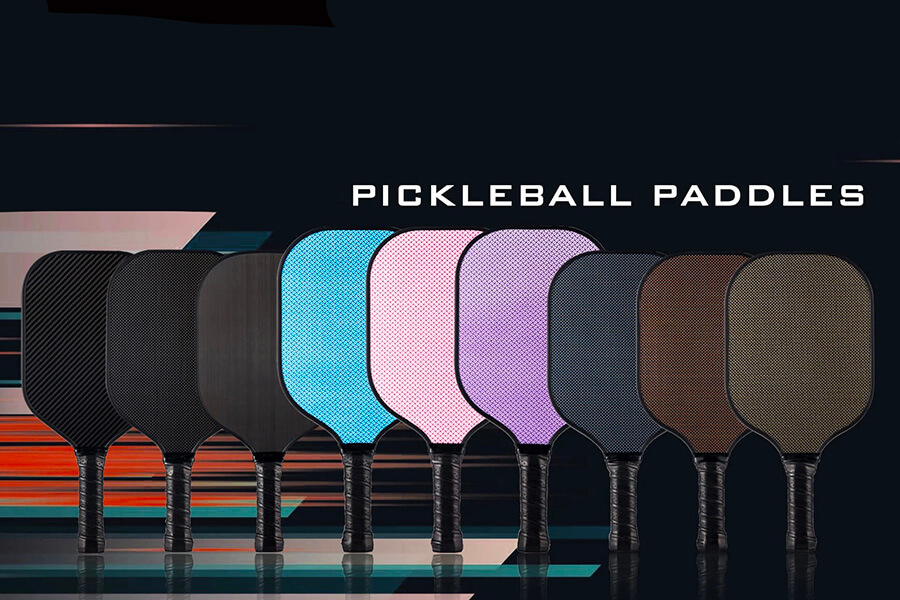
Pickleball is a sport that combines elements of tennis, badminton, and table tennis. It was invented in 1965 by three fathers in Washington State, USA, as a fun way to keep their families entertained during the summer. The game quickly gained popularity and has since evolved into a widely played sport with a growing global community.
Over the years, pickleball has undergone several changes and improvements, including the development of official rules and the establishment of governing bodies such as the USA Pickleball Association. The sport has also expanded beyond the United States, with pickleball associations and clubs now present in various countries around the world.
The pickleball paddle is an essential piece of equipment for players, as it determines how the ball is struck, the level of control a player has, and the power generated during shots. A well-chosen paddle can significantly impact a player’s performance and overall enjoyment of the game.
When selecting a pickleball paddle, players should consider factors such as weight, grip size, balance, and materials used in the paddle’s construction. These factors can influence the paddle’s performance, durability, and suitability for a player’s skill level and playing style.
Pickleball paddles are made from a variety of materials, including wood, composite, fiberglass, carbon fiber, graphite, polymer, and Nomex. Each material offers unique characteristics that can impact the paddle’s performance, weight, and durability.
The choice of material for a pickleball paddle can significantly affect how the paddle performs on the court. Some materials offer improved power, control, or maneuverability, while others prioritize durability or affordability. Understanding the properties of each material is crucial for selecting a paddle that best suits a player’s needs.
This blog aims to provide an in-depth understanding of the different materials used in the construction of pickleball paddles. By exploring the advantages and disadvantages of each material, we hope to help readers make informed decisions when selecting a paddle that best suits their playing style, skill level, and budget.
In addition to helping readers choose the right paddle, this blog will also explore how the choice of material affects other aspects of the paddle, such as weight, balance, and surface texture. Understanding these factors can provide valuable insights for players looking to improve their game or invest in a new paddle.
Wooden paddles were the first type of pickleball paddle used when the sport was invented. Despite the introduction of more advanced materials, wood remains a popular choice for some players, particularly beginners and recreational players.
Wooden paddles are generally the most affordable option, making them an attractive choice for those on a budget or new to the sport.
Wooden paddles are known for their durability, providing a long-lasting option for players.
Wooden paddles tend to be heavier than those made from other materials, which may result in reduced maneuverability and increased fatigue during play.
Wooden paddles often lack the advanced features found in paddles made from other materials, such as improved power or control.
Due to their affordability and durability, wooden paddles are an excellent option for those just starting out in the sport.
Wooden paddles are also suitable for casual players who prioritize cost and durability over advanced performance features.
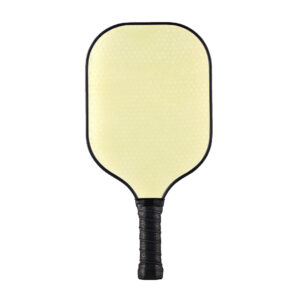
Composite paddles are made from a combination of materials, such as fiberglass and carbon fiber, and a core material like aluminum, polymer, or Nomex honeycomb. They have become popular due to their lightweight construction and performance-enhancing features.
Composite paddles are lighter than wooden paddles, allowing for greater maneuverability and reduced fatigue during play.
Composite paddles offer a wide range of material and core combinations, enabling players to choose a paddle that best suits their playing style and preferences.
Composite paddles are generally more expensive than wooden options, which may make them less accessible for some players.
Some composite paddles may not be as durable as wooden or carbon fiber options, depending on the materials used.
Composite paddles are an excellent choice for intermediate and advanced players looking for improved performance and a lightweight paddle.
Due to their performance-enhancing features, composite paddles are popular among competitive players who seek an edge on the court.
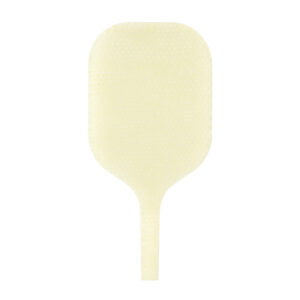
Fiberglass, also known as glass fiber, has been used in various applications since the 1930s, including aerospace, automotive, and marine industries. In pickleball, fiberglass is often used as a surface material in composite paddles.
Fiberglass is lightweight, which allows for improved maneuverability during play.
As part of a composite paddle, fiberglass can be combined with various core materials to achieve different performance characteristics.
Fiberglass paddles offer a balanced performance in terms of power and control.
Fiberglass may be less durable than some other paddle materials, such as carbon fiber.
Fiberglass composite paddles can be more expensive than other options, such as wood or polymer.
Fiberglass paddles are well-suited for players who want a lightweight, balanced paddle that offers a good combination of power and control. They are often recommended for intermediate to advanced players who are looking to enhance their gameplay.
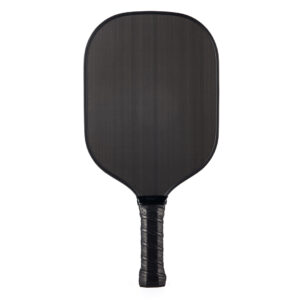
Carbon fiber, a high-performance material known for its strength and lightweight properties, has been used in various industries, including aerospace, automotive, and sports equipment. In pickleball, carbon fiber is often utilized as a surface material in composite paddles for its exceptional performance characteristics.
Carbon fiber paddles are typically lighter than other options, allowing for increased maneuverability and reduced player fatigue.
Carbon fiber offers a high strength-to-weight ratio, which translates into excellent performance on the court.
Carbon fiber paddles often provide more power and control compared to other materials, making them ideal for competitive players.
Carbon fiber paddles can be more costly than other paddle materials, which may be a barrier for some players.
Carbon fiber paddles are best suited for advanced players who prioritize performance and are willing to invest in a high-quality paddle. The lightweight construction and excellent power and control characteristics make carbon fiber paddles a popular choice among competitive players.
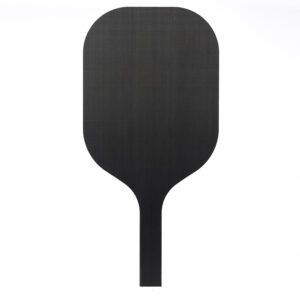
Graphite paddles were introduced in the 1980s and quickly gained popularity due to their lightweight construction and high-performance capabilities. Graphite paddles are a popular choice among advanced and competitive players.
Graphite paddles are among the lightest options available, allowing for improved maneuverability and reduced fatigue during play.
Graphite paddles offer a high strength-to-weight ratio, providing excellent power and control while maintaining a lightweight construction.
Graphite paddles are generally more expensive than wood and fiberglass options, which may make them less accessible for some players.
Graphite paddles are an ideal choice for advanced players seeking the best possible performance from their paddle.
The lightweight construction and high strength-to-weight ratio of graphite paddles make them popular among players looking to optimize their game.
Aluminum honeycomb cores are lightweight and provide a good balance between power and control.
Paddles with aluminum honeycomb cores offer moderate power and control, making them suitable for a wide range of playing styles.
Aluminum honeycomb cores are generally durable and provide a long-lasting option for players.
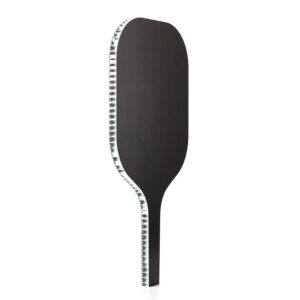
Polymer honeycomb cores are lightweight, affordable, and offer a good balance of power and control.
Paddles with polymer honeycomb cores provide moderate power and control, making them suitable for a variety of playing styles.
Polymer honeycomb cores are known for their durability and longevity, making them a popular choice among players.
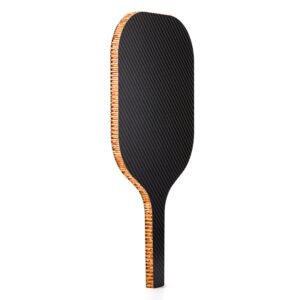
Nomex honeycomb cores are lightweight, strong, and provide excellent power and control.
Paddles with Nomex honeycomb cores offer superior power and control, making them popular among advanced and competitive players
Nomex honeycomb cores are generally durable, but their longevity may be influenced by factors such as paddle construction and the specific combination of materials used.
The choice of paddle material has a significant impact on its weight, with lighter materials like graphite and composite offering improved maneuverability and reduced fatigue during play. Heavier materials like wood may be more durable but can limit performance due to their increased weight.
Paddle balance plays a crucial role in gameplay, as it affects the paddle’s performance in terms of power, control, and maneuverability. A well-balanced paddle allows players to optimize their game and enhance their skills on the court.
When choosing a paddle, it’s essential to consider your skill level and playing style. Beginners may benefit from a heavier paddle for added stability and control, while advanced players often prefer lighter paddles for improved maneuverability and quicker response time.
The surface texture of a paddle can greatly influence ball control, spin, and overall performance. A rougher surface texture can generate more spin on the ball, while a smoother surface may provide better control and consistency.
Different materials offer varying levels of surface texture, with some materials like fiberglass and graphite providing more texture for added ball control and spin. On the other hand, materials like wood and polymer tend to have smoother surfaces and may not provide the same level of control.
Each of these surface textures can significantly impact gameplay, and players should choose a paddle with a surface texture that best suits their playing style and preferences.
Wooden paddles are cost-effective and durable, making them suitable for beginners and recreational players.
Composite paddles offer a lightweight construction and a variety of materials and core options, making them ideal for intermediate to advanced players. They include:
Fiberglass paddles provide a good balance of power, control, and durability.
Carbon fiber paddles offer excellent performance and durability but can be more expensive than other options.
Graphite paddles are lightweight and high-performing, making them popular among advanced players seeking optimal performance.
Different core materials, such as aluminum, polymer, and Nomex honeycomb cores, can influence a paddle’s performance, durability, and overall feel.
The material choice significantly affects a paddle’s weight and balance, which in turn influences maneuverability, power, control, and player fatigue.
The surface texture of a paddle, determined by the material choice, can greatly impact ball control and spin during gameplay.
It’s essential to choose a paddle that suits your playing style and preferences, as it can enhance your performance on the court and increase your enjoyment of the game.
Before investing in a paddle, it’s beneficial to borrow or rent different options to get a feel for what suits you best.
Attending demo days and events can provide opportunities to test out various paddles and receive advice from experienced players and manufacturers.
Selecting the right paddle is an investment in your game, and taking the time to make an informed decision can lead to long-term satisfaction and enjoyment.
Choosing a paddle that aligns with your playing style and preferences can enhance your overall enjoyment of the game and motivate you to continue improving your skills.
By investing in the right paddle and continuously improving your skills, you contribute to the growth and popularity of the sport of pickleball.
As players become more knowledgeable about paddle materials and share their experiences, the pickleball community becomes more supportive and well-informed, promoting a welcoming environment for players of all skill levels.